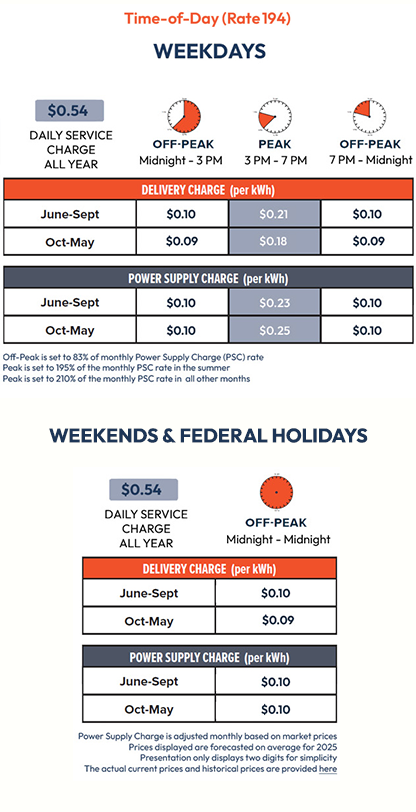Time Your Savings Series:
Get to know off-peak vs. peak
Find out the difference between off-peak and peak pricing and the benefits of using electricity during certain
times
on the new standard Time-of-Day rate.
Off-peak and Peak Hours
The standard Time-of-Day Rate has off-peak hours that make up more than
88% of the hours in the year, while peak hours make up only
12% or less throughout the year.
Off-peak hours: During off-peak hours, electricity costs are generally less than the flat rate
you
may be familiar with (ex. Rate 180). Along with weekday off-peak hours, every weekend and all federal holidays
are
entirely off-peak.
Peak hours: The peak hours from 3 PM to 7 PM, Monday to Friday, is when electricity is the most
costly to produce and use. To maximize savings, reduce electricity use during peak hours by shifting as much
energy
use as you can to off-peak hours (we have many savings tips online). Only weekdays have peak hours.
Learn more about off peak vs on peak energy
Time-of-Day Cost Breakdown

Time-of-Day will shift to “winter” pricing on October 1 until the end of May 2026.
For more information on current rates, download the
Residential Rates brochure.
For a detailed look at monthly Power Supply Charges
click here.
Guaranteed Bill Protection

Guaranteed
Bill Protection
Although energy bills are typically higher during the warm weather months, the goal with a Time-of-Day Rate is
to save over the course of a full year. Even if one bill does not show savings, give it time. Plus, most
customers new to the Time-of-Day Rate can try it out for up to one year with nothing to lose. During your first
12 months on the rate only, if you do not save money, we will automatically credit the difference to your
account.*